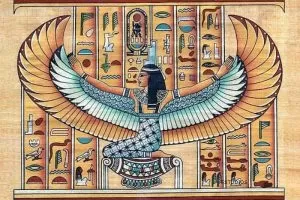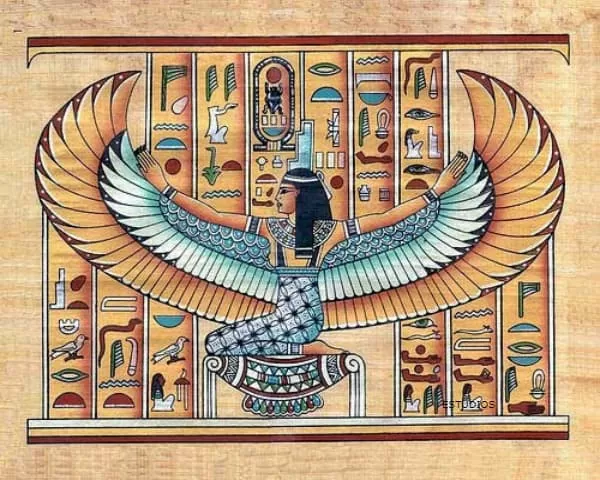Meaning of the Goddess Isis
Isis, the Egyptian Aset or Eset, one of the most important goddesses of ancient Egypt. Her name is the Greek form of an ancient Egyptian word for “throne”.
Isis is the female archetype for creation; She is the goddess of fertility and motherhood. She has had many names and has played many roles in history and mythology as a goddess and female creator. Her name literally means Queen of the Throne. Her original headdress was an empty throne chair that belonged to her murdered husband, Osiris. The hieroglyph of her name originally used means (feminine) flesh, i.e. mortal, and may have simply represented deified and royal queens.
The most commonly used name for this deity, Isis, is a Greek corruption of the Egyptian name; and its pronunciation as ‘eye-is’ is a further corruption by English speakers. The true Egyptian pronunciation is unknown, as the Egyptian hieroglyphs only recorded consonants and left out most vowels. The Egyptian hieroglyphs for your name are commonly transcribed as jst; as a convenience, Egyptologists pronounce it as ee-set.
Who is the Goddess Isis ?
Isis was initially a dark goddess who lacked her own dedicated temples, but grew in importance as the dynastic era progressed, until she became one of the most important deities of ancient Egypt. Her worship later spread throughout the Roman Empire, and Isis was worshipped from England to Afghanistan. She’s still revered by pagans today.
As a mourner, she was a major deity in rituals related to the dead; as a magical healer, she healed the sick and gave life to the deceased; and as a mother, she was a model for all women.
What Attributes Does the Goddess Isis Have ?
Isis had strong ties to Egyptian royalty, and was most often depicted as a beautiful woman in a sheath dress and the hieroglyphic sign of the throne or a sun dial and cow horns on her head.
Occasionally she was depicted as a scorpion, a bird, a sow or a cow. There are no references to Isis before the 5th dynasty (2465-2325 BC), but she is mentioned many times in the Pyramid Texts (c. 2350 BC), where she offers assistance to the dead king.
Later, as ideas of life after death became more democratic, Isis was able to extend her assistance to all dead Egyptians.
In art, Isis was originally depicted as a woman in a long dress and crowned with the hieroglyphic sign of a throne. Sometimes she was depicted holding a lotus or as a sycamore tree. A pharaoh,
Thutmose III, was depicted in her tomb while nursing from a sycamore tree that had a breast.
After she assimilated many of Hathor’s roles, Isis’ headdress is replaced with Hathor’s: the horns of a cow on her head, with the sun disk between them. Sometimes she was also depicted as a cow, or the head of a cow.
Generally, however, she was depicted with her young son, Horus (the pharaoh), wearing a crown and a vulture. Occasionally she was depicted as a kite flying over the body of Osiris or with Osiris dead in her lap as she worked her magic to bring him back to life.
Most of the time, Isis is seen holding only the generic ankh sign and a simple staff, but in the later images she is sometimes seen with items usually associated only with Hathor, the sacred necklace and the one that carries fertility.
In some books Isis is depicted on the bow of the Solar Crust with her arms outstretched.
What is the Power of the Goddess Isis ?
Isis was the perfect traditional Egyptian wife and mother, happy to stay in the background while things were going well, but she could use her wits to protect her husband and son if necessary. The refuge she gave her son gave her the character of a goddess of protection. But her main aspect was that of a great magician, whose power transcended that of all other deities. Several stories speak of her magical prowess, much stronger than the powers of Osiris and Re.
She was often invoked in the name of the sick, and with the goddesses Nephthys, Neith and Selket, she protected the dead. Isis associated with several other goddesses, including Bastet, Nut and Hathor, and thus her nature and powers became more and more diverse. Isis became known, like other fierce goddesses in the Egyptian pantheon, as the “Eye of Re” and was compared to the dog star, Sothis (Sirius).
History of the Goddess Isis
Origins
In the typical form of her myth, Isis was the first daughter of Geb, god of the Earth, and Nut, goddess of the sky, and was born on the fourth intercalary day. She married her brother, Osiris, and she conceived Horus with him. Isis was instrumental in the resurrection of Osiris when he was killed by Seth. Using her magical abilities, she restored his body to life after gathering the body parts that Seth had scattered on the earth.
Most Egyptian deities were worshipped first by local cults, and eventually their popularity spread, so most of the major cities and towns in Egypt were known as the home of a particular deity. The origins of the cult of Isis are uncertain, but it is believed that it was originally a popular and independent deity in pre-dynastic times, before 3100 BC, in Sebennytos, in the Nile Delta.
The first written references to Isis date back to the fifth dynasty of Egypt. Based on the association of her name with the throne, some early Egyptologists believed that the original function of Isis was that of a mother-throne. However, more recent studies suggest that aspects of that role came later by association. In many African tribes, the throne is known as the king’s mother, and that concept fits well with either theory, possibly giving an insight into the thinking of the ancient Egyptians.
The myth of Isis-Osiris became very important during the Greco-Roman period with sanctuaries at Delos and Pompeii. It was believed that the river Nile was flooded every year because of the tears of pain that Isis wept for Osiris. The death and rebirth of Osiris was revived every year through rituals. The worship of Isis eventually spread throughout the Greco-Roman world, continuing until the suppression of paganism in the Christian era.
As the great lady of the underworld, who helped transform the bodies of the blessed dead into those that should live in the kingdom of Osiris, she was Ament, the hidden goddess, mother of Ra. In this capacity, she shared with Osiris the attribute of the Giver of Life who provides food for both the dead and the living. In a comparatively early period in Egyptian history, Isis had absorbed the attributes of all the great primitive goddesses, and of all the local goddesses such as Nekhebet, Uatchet, Net, Bast, Hathor, etc.
She was even identified as the female counterpart of the primitive water abyss from which all life sprang. It is impossible to limit the attributes of Isis, who possesses the powers of a water goddess, an earth goddess, a corn goddess, a star goddess, a queen of the underworld and a woman, and that she joined in herself one or more of the attributes of all the goddesses of Egypt that we know.
Isis was first worshipped in Egypt: the only goddess worshipped by all Egyptians equally, and whose influence was so widespread that she had become completely syncretic with the Greek goddess Demeter. After the conquest of Egypt by Alexander the Great and the Hellenization of Egyptian culture initiated by Ptolemy I Soter, Isis became known as the Queen of Heaven.
After the conquest of Egypt by Alexander the Great, the worship of Isis spread all over the Greco-Roman world. Tacitus writes that after the assassination of Julius Caesar, a temple had been decreed in honor of Isis; Augustus suspended this and tried to return the Romans to the Roman deities that were closely associated with the state. Finally, the Roman Emperor Caligula abandoned Augustus’ caution towards what were described as oriental cults, and it was during his reign that the Isis festival of Navigium Isidis was established in Rome.
According to Josephus, Caligula wore feminine attire and participated in the mysteries he instituted, and in the Hellenistic era, Isis acquired a “new rank as a goddess of the Mediterranean world. Vespasian, along with Titus, practiced incubation in the Roman Iseum. Domitian built another Iseum together with a Serapeum. Trajan appears before Isis and Horus, presenting them with votive offerings of wine, in a bas-relief on his triumphal arch in Rome.
Hadrian decorated his villa in Tibur with Isis scenes. Galerius considered Isis to be his protector. Roman perspectives on cults were syncretic, seeing in new deities simply local aspects of a familiar one. For many Romans, the Egyptian Isis was an aspect of the Cybele Phrygia, whose orgiastic rites had long been naturalized in Rome, in fact, she was known as Isis of Ten Thousand Names.
Among these names of the Roman Isis, the Queen of Heaven stands out for her long and continuous history. Herodotus identified Isis with the Greek and Roman goddesses of agriculture, Demeter and Ceres. In later years, Isis also had temples all over Europe, Africa and Asia. A third century BC statue of Isis, found in Ohrid in the Republic of Macedonia, is represented on the front of the Macedonian 10-denarius note, issued in 1996.
The male name “Isidore” means in Greek “gift” of Isis “(similar to” Theodore “,” the gift of God “).
The name, which became common in Roman times, survived the suppression of the worship of Isis and remains popular to this day, being among others the name of several Christian saints. The worship of Isis in Rome was a template for the Christian worship of the Virgin.
Myths About the Goddess Isis
The myth of Isis, Osiris and Horus became one of the most important and powerful in Egyptian mythology during the New Kingdom. The myth refers to the death of Osiris and the birth of Horus.
The original form of the myth states that Osiris was killed by a wooden sarcophagus that Set made secretly to his measurements, that he was jealous of Osiris’ position as Pharaoh, and therefore conspired to kill him and take his place.
A feast had been held where the coffin was offered to anyone who could enter. Some people tried to fit in, but to no avail. Osiris dared to try, but as soon as he lay down, the lid slammed shut. Then it was sealed with lead and thrown into the river Nile.
Hearing that Osiris had gone, Isis set out to find him. She feared that, without the proper ceremonies and burial, Osiris would not be able to go to the place of the dead.
Later she learned that the coffin had floated down the Nile River to the coast of Vilos (now in modern Lebanon) and had been embedded in the trunk of a cedar tree.
He also learned that the cedar had been taken and used as a pillar to support a palace for the King of Byblos. On his way back, along the river Nile, he left the coffin in a swamp area.
Seth, while hunting, found Osiris’ coffin and dismembered it into 14 parts, scattering them over the land of Egypt.
Once again, Isis set out to look for the pieces and was able to find 13 of the 14 parts, with the help of Nephthys, Seth’s sister-wife, but she could not find the 14, as it had been eaten by a fish.
Instead, she made a golden phallus and sang a song around Osiris until he came back to life. Osiris was resurrected. He could have proper ceremonies and burial. Because of this experience, Osiris became the Lord of the Dead and the Beyond.
In late Egyptian thought, it was sometimes said that the righteous dead became the stars, and so sometimes the moon was considered to have a connection with Osiris, Lord of the Dead.
As a legend of death and resurrection, in which evil seeks to destroy a deity, thus bringing about darkness, it developed an association with the lunar cycle, in which the moon appears to be destroyed by darkness, and then returns to life.
Therefore, it was later said that Osiris was killed by dismembering into 13 parts, each representing one of the 13 full moons seen each year (there are approximately 13 lunar months per year).
Another interpretation is that the pieces were 14 (in some versions up to 16) were the phases of the single moon cycle (a splinter cut each night for 14 days, then reassembled for the next 14 days.
The original form of Set The Assassination of Osiris was incorporated into this later version, although the attempt was said to have failed when Isis and Nepthys found the coffin and rescued it.
Consequently, the story became that before Osiris was resurrected, Isis put together 13 of the 14 parts, but could not find the 14th, his phallus, which was eaten by the oxyrhynchus fish (a fish with an unusual curved snout that resembles Seth’s depictions).
So Isis created a phallus for him, and then tried to revive it. In some versions, Isis sang a song around Osiris until he came back to life. Then she took the form of a kite and flew around his body to conceive Horus.
In other accounts of the story, Isis grows wings and hovers over Osiris. She gives him life to revive him and conceive Horus. Being simultaneously alive and dead, Osiris became the god and king of the future life.
As a deity of life-death-rebirth, Horus/Osiris became a reflection of the annual cycle of crop harvesting as well as reflecting people’s desires to have a successful afterlife, so the legend became extremely important, surpassing all others.
The legend’s adventures into life and the afterlife meant that the religious rites associated with the legend eventually began to take on aspects of a mysterious religion.
Where it was said that initiates could participate in the resurrection of Horus/Osiris, purging themselves of past evils, and entering into a new life.
This myth has been told in various ways, but the message is always the same: death and resurrection, a metaphor for the journey of the soul in the games of physical reality.
Isis and Ra
It was said that Isis tricked Ra (i.e. Amun-Ra / Atum-Ra) into telling him his “secret name” by having a snake bite him, for which only Isis had the cure.
Knowing the secret name of a deity allowed one to have the power of the deity. The use of secret names became central to late Egyptian magic spells, and Isis is often implored to “use the true name of Ra” in performing rituals.
Sons of the Goddess Isis
Isis often appears as Horus’ mother.
Temples of the Goddess Isis
In Greco-Roman times, many of the priests were considered healers, said to have other special powers, including dream interpretation and the ability to control the weather, which they did by braiding or not braiding their hair.
The latter was believed because the Egyptians considered that knots had magical powers.
The Temple of Isis is a Roman temple dedicated to the Egyptian goddess Isis. This small and almost intact temple was one of the first discoveries during the excavation of Pompeii in 1764.
Its role as a Hellenized Egyptian temple in a Roman colony was fully confirmed by a detailed inscription by Francisco la Vega on 20 July 1765.
Paintings and sculptures can be seen at the Archaeological Museum of Naples; the site itself remains on Via del Tempio di Iside. After the discovery of the temple many famous artists and illustrators came to the site.
The preserved Pompeian temple is actually the second structure; The original building built under Augustan was damaged in an earlier earthquake of 62 AD.
Seventeen years later, with the massive volcanic eruption, only the Iseum was the only temple that was completely rebuilt, even in front of the Capitol.
Although the Iseum was located in a small, narrow space, it received considerable pedestrian traffic from theatergoers in the Grand Theater, businessmen in the Triangular Forum, and others along the Stabia Gate.
It is assumed that the main devotees of this temple were women, freedmen and slaves.
Initiates of the mystery cult of Isis worshipped a compassionate goddess who promised eventual salvation and a perpetual relationship throughout life and after death.
The temple itself was rebuilt in honor of a 6 year old boy by his free man father, Numerius, to allow the boy to enter the elite society.
Many scenes from the temple are recreated in the dining rooms of Pompeii, however, indicating that many people visited this temple for political, economic or social reasons.
Isis was a goddess of the religious beliefs of ancient Egypt, whose worship spread throughout the Greco-Roman world. She was worshipped as the ideal mother, wife, nature and magic matron.
She was a friend of slaves, sinners, artisans, the oppressed, who also listened to the prayers of the rich, the maidens, the aristocrats and the rulers.
The worship of Isis was concerned with the acquisition of knowledge, since knowledge could only be obtained from the gifts of the gods.
The priests of Isis typically shaved their heads and wore linen clothes instead of wool.
The worship of Isis did not include a messianic worldview, but it did provide a relationship with the divine that was not broken by death. In common with other deities, Isis did not demand exclusive worship, but in practice, her devotees applied, from a modern perspective, a henotheistic perspective.
It is believed that the cult of Isis reached Pompeii around 100 BC. After the destruction of the first temple in the earthquake of 62 AD, the son of Numbers paid for its complete reconstruction.
The setting and decorations provided an attractive backdrop for the liturgical rites. These services were held daily with a solemn opening in the morning and a closing in the evening filled with singing.
A ritual bucket for the sacred water of the Nile, the situla, and a rattle, the sistrum, were used in worship. It is known that the Temple of Isis was the most variable due to the worship of Isis.
The first main temple dedicated to Isis was built by the Late Period king Nectanebo II (360-343 BC) at Behbeit el-Hagar in the central delta of the Nile.
Other important temples, including the temple on the island of Philae, were built during the Greco-Roman era when Isis was dominant among the Egyptian goddesses. Several temples were dedicated to her in Alexandria, where she became the patron saint of seafarers.
From Alexandria, her worship spread to Greece and Rome. The images of Isis nursing baby Horus may have influenced the early Christian artists who depicted the Virgin Mary with the baby Jesus.
As the personification of the throne, she was an important source of Pharaoh’s power. The Pharaoh was depicted as her son, who sat on the throne she provided.
Her worship was popular throughout Egypt, but the most important shrines were at Behbeit El-Hagar in the Nile Delta and, from the reign of Nectanebo I (380-362 BC), on the island of Philae in Upper Egypt.
Temples dedicated to Isis were built in Iraq, Greece and Rome, with one well-preserved example discovered in Pompeii.
On the Greek island of Delos, a Doric temple to Isis was built on an elevated hill overlooking the beginning of the Roman era to worship the family trinity of Isis, the Alexandrian Serapis and Harpocrates.
The creation of this temple is important, as Delos is particularly known as the birthplace of the Greek gods Artemis and Apollo, who had their own temples on the island long before the temple of Isis was built.
Temple of Isis at Philae
The cult of Isis and Osiris continued until the 6th century BC on the island of Philae in the Upper Nile. The Theodosian decree (in approximately 380 CE) to destroy all pagan temples was not applied there until the time of Justinian.
This tolerance was due to an ancient treaty made between Blemyes-Nobadae and Diocletian. Every year they visited Elephantine and at certain intervals took the image of Isis upstream to the land of the Blemyes for oracular purposes before returning it.
Justinian sent Narses to destroy the shrines, with the priests arrested and the divine images taken to Constantinople. Philae was the last of the ancient Egyptian temples to be closed.
Little information survives about Egyptian rituals for Isis; however, it is clear that there were priests and priestesses officiating at her worship throughout her history.
Related Topics

ARTEMIS GODDESS: Characteristics, Powers and History

HELA: Goddess of Norse Mythology: Powers and Meaning

THE GODDESSES OF MYTHOLOGY: Their Names and Meanings
Other Gods of Mythology in ALPHAPEDIA
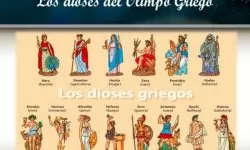
OLIMPUS GODS: ¿ Who Are ? ¿ What Are ? Names and Powers
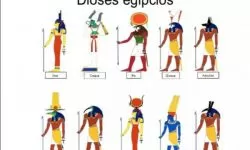
EGYPTIAN GODS: Their Names and Meanings

THE GODDESSES OF MYTHOLOGY: Their Names and Meanings
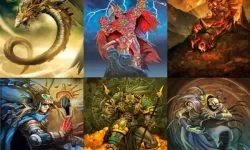
AZTEC GODS: List of Names, Meanings and Powers
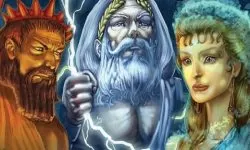
GREEK GODS: Names, Family Tree and Their Powers

NORSE GODS: Names, Meaning, Powers and History
Other Topics of Interest in ALPHAPEDIA

FREE BACHELOR DEGREE IN CIVIL PROTECTION

FREE MARKETING COURSE
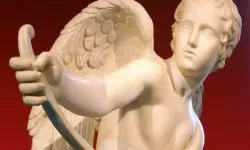
EROS GOD: Meaning, Mythology, Facts and Attributes

FREE INFORMATION SYSTEMS COURSE

FREE ANATOMY COURSE

FREE BACHELOR DEGREE IN THANATOPRAXY
Images, Photos and Drawings of Goddess Isis
